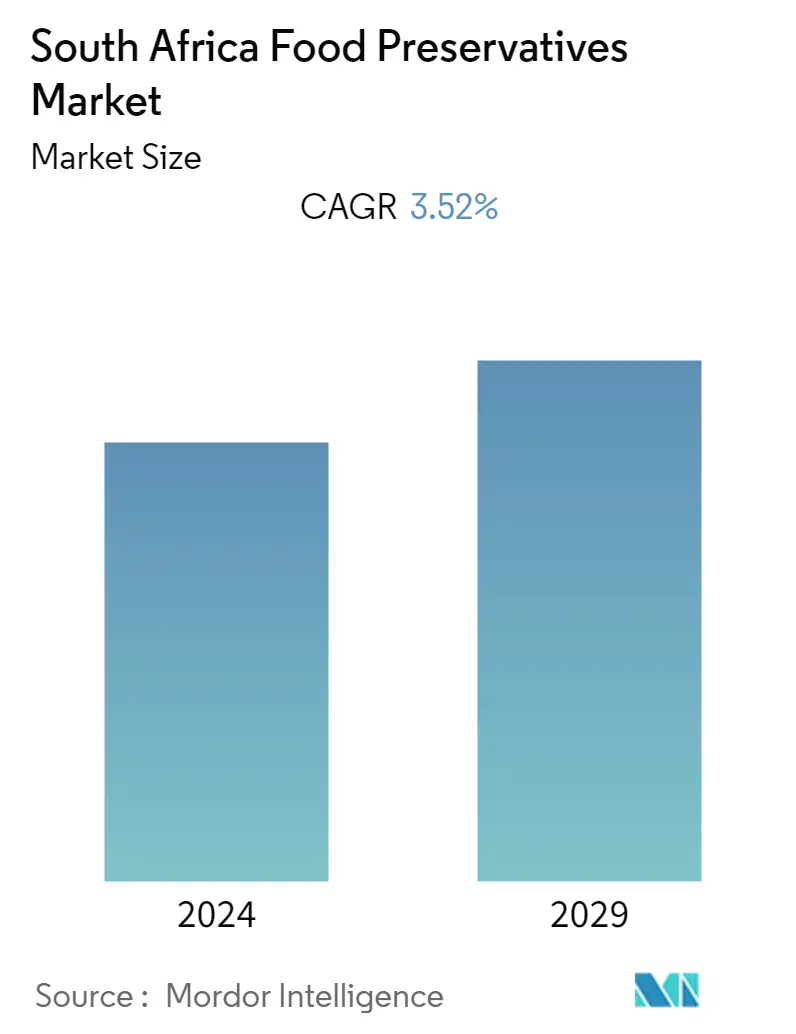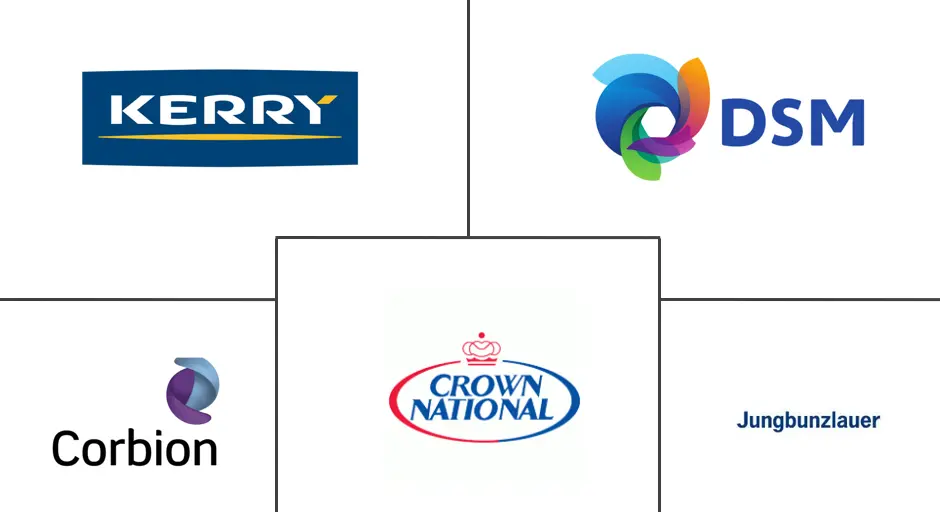Market Size of South Africa Food Preservatives Industry

| Study Period | 2019 - 2029 |
| Base Year For Estimation | 2023 |
| Forecast Data Period | 2024 - 2029 |
| Historical Data Period | 2019 - 2022 |
| CAGR | 3.52 % |
| Market Concentration | Low |
Major Players
*Disclaimer: Major Players sorted in no particular order |
South Africa Food Preservatives Market Analysis
South Africa's food preservatives market is projected to grow, witnessing a CAGR of 3.52% during the forecast period (2020 - 2025).
- The preservatives market in South Africa is largely driven by demand for convenience and packaged foods by the burgeoning population and rising urbanization rates.
- Thee increase in the formal retail segment is driving the market for processed foods in the Sub Saharan region, thus driving the food preservatives market in the country. Furthermore, the supply chain complexity and low infrastructure in Africa are seen by manufacturers estimating a huge potential for the preservatives market to meet the food security and safety of the region, including South Africa.
- The major constraint is the increased awareness of the ill effects of synthetic ingredients and growing consumer demand for fresh and natural foods. Companies are seeing this as an opportunity to innovate and provide solutions in the form of natural and functional ingredients.
South Africa Food Preservatives Industry Segmentation
The South Africa food preservatives market offers a variety of preservatives including natural and synthetic types applicable to beverage, dairy & frozen product, bakery, meat, poultry & seafood, confectionery, sauces & salad mixes, and other industries.
| By Type | |
| Natural | |
| Synthetic |
| By Application | |
| Beverage | |
| Dairy & Frozen Product | |
| Bakery | |
| Meat, Poultry & Seafood | |
| Confectionery | |
| Sauces and Salad Mixes | |
| Others |
South Africa Food Preservatives Market Size Summary
The South Africa food preservatives market is experiencing growth driven by the increasing demand for convenience and packaged foods, fueled by a growing population and rising urbanization. The expansion of the formal retail sector in the Sub-Saharan region is further propelling the market for processed foods, thereby boosting the demand for food preservatives in South Africa. Despite challenges such as supply chain complexities and inadequate infrastructure, manufacturers see significant potential in addressing food security and safety concerns. However, the market faces constraints due to heightened consumer awareness regarding the negative effects of synthetic ingredients, leading to a shift towards fresh and natural foods. This shift presents opportunities for companies to innovate by offering natural and functional ingredients as alternatives to traditional chemical preservatives.
The current market trend emphasizes the demand for natural and clean label food products, which is significantly impacting the preservatives and antioxidants category. This trend poses a challenge to traditional chemical preservatives, as natural alternatives like rosemary extract gain popularity. The availability of organic acids in fruits has facilitated the adoption of clean label preservatives, further driving market growth. Producers are leveraging organic acids such as sorbic and benzoic acids as natural preservatives, contributing to the market's expansion. The meat, poultry, and seafood sectors are identified as lucrative segments for growth, supported by innovative preservation solutions, including natural-based additives. Leading global and domestic players in the food preservatives market are focusing on research and development to meet the increasing consumer preference for natural preservatives, thereby enhancing their market position in South Africa.
South Africa Food Preservatives Market Size - Table of Contents
-
1. MARKET DYNAMICS
-
1.1 Market Drivers
-
1.2 Market Restraints
-
1.3 Porter's Five Forces Analysis
-
1.3.1 Threat of New Entrants
-
1.3.2 Bargaining Power of Buyers/Consumers
-
1.3.3 Bargaining Power of Suppliers
-
1.3.4 Threat of Substitute Products
-
1.3.5 Intensity of Competitive Rivalry
-
-
-
2. MARKET SEGMENTATION
-
2.1 By Type
-
2.1.1 Natural
-
2.1.2 Synthetic
-
-
2.2 By Application
-
2.2.1 Beverage
-
2.2.2 Dairy & Frozen Product
-
2.2.3 Bakery
-
2.2.4 Meat, Poultry & Seafood
-
2.2.5 Confectionery
-
2.2.6 Sauces and Salad Mixes
-
2.2.7 Others
-
-
South Africa Food Preservatives Market Size FAQs
What is the current South Africa Food Preservatives Market size?
The South Africa Food Preservatives Market is projected to register a CAGR of 3.52% during the forecast period (2024-2029)
Who are the key players in South Africa Food Preservatives Market?
Corbion N.V., Koninklijke DSM N.V., Crown National, Prime Pharma, Cape Food Ingredients and Kerry Group plc are the major companies operating in the South Africa Food Preservatives Market.

